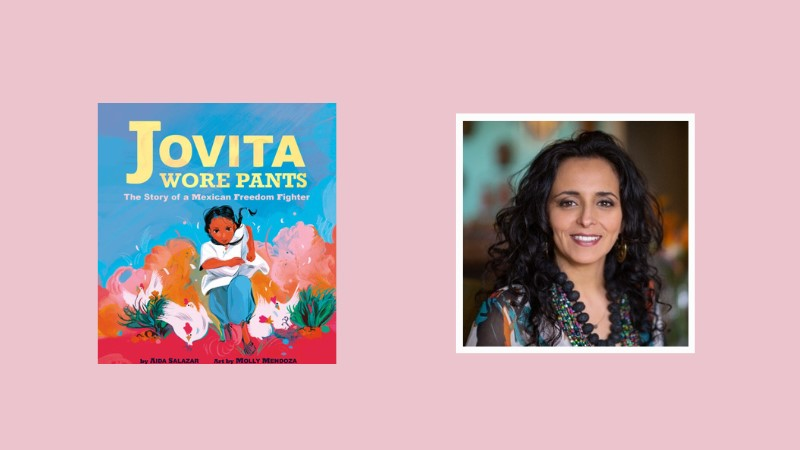 We got a chance to hear from author Aida Salazar about her picture book “Jovita Wore Pants,” illustrated by Molly Mendoza, as part of a series honoring and celebrating creators and stories for Hispanic and Latine Heritage Month. “Jovita Wore Pants” tells the remarkable true story of a Mexican freedom fighter who defied the societal restrictions placed upon young girls in her time and culture and fought for religious freedom with bravery and determination.
We got a chance to hear from author Aida Salazar about her picture book “Jovita Wore Pants,” illustrated by Molly Mendoza, as part of a series honoring and celebrating creators and stories for Hispanic and Latine Heritage Month. “Jovita Wore Pants” tells the remarkable true story of a Mexican freedom fighter who defied the societal restrictions placed upon young girls in her time and culture and fought for religious freedom with bravery and determination.
The book centers on Jovita, a Mexican heroine fighting for religious freedom who also happens to be your distant great-aunt. What was the process like putting the pieces together of such an influential family member?
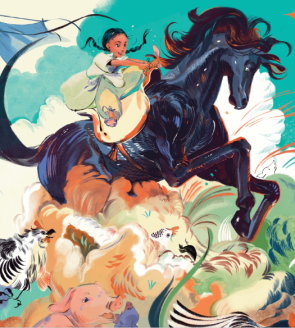 My mother had very fond memories of her tia Jovita and that was the initial spark. Then, my mom shared with me a copy of Jovita’s memoir: Jovita la cristera. When I read it, I understood immediately how significant her life had been, though hardly known to others as there were only one thousand copies printed of her book. It wasn’t until a couple of decades later, when I was embarking on my career as a children’s author, did I decide to share it with children. One of the reasons why Jovita wrote her memoir was because she didn’t want others to speak for her. She wanted to be the one to tell her story. The picture book is based most heavily on her accounts of what happened. I did conduct many additional interviews in Mexico and in Los Angeles with relatives and people who knew her, including her niece Marta Viramontes Medina who pulled the memoir together based on cassette tape recordings of Jovita telling her story. I also did extensive research in archives, books, news articles, and internet searches that spoke about the experience of the Cristero War. Jovita Valdovinos was a controversial person in many ways and war is a difficult, gruesome experience. However, what I focused on in the interviews and in my additional research was the sheer courage it took for Jovita to defy gender expectations of her time and culture inspired by her devotion to her family.
My mother had very fond memories of her tia Jovita and that was the initial spark. Then, my mom shared with me a copy of Jovita’s memoir: Jovita la cristera. When I read it, I understood immediately how significant her life had been, though hardly known to others as there were only one thousand copies printed of her book. It wasn’t until a couple of decades later, when I was embarking on my career as a children’s author, did I decide to share it with children. One of the reasons why Jovita wrote her memoir was because she didn’t want others to speak for her. She wanted to be the one to tell her story. The picture book is based most heavily on her accounts of what happened. I did conduct many additional interviews in Mexico and in Los Angeles with relatives and people who knew her, including her niece Marta Viramontes Medina who pulled the memoir together based on cassette tape recordings of Jovita telling her story. I also did extensive research in archives, books, news articles, and internet searches that spoke about the experience of the Cristero War. Jovita Valdovinos was a controversial person in many ways and war is a difficult, gruesome experience. However, what I focused on in the interviews and in my additional research was the sheer courage it took for Jovita to defy gender expectations of her time and culture inspired by her devotion to her family.
Did you grow up with family stories of your great-aunt and were there any surprises for you when you started to research her story for your book?
Yes, my mother shared many stories of sitting with Jovita and my grandfather, who were cousins and who was also a Cristero. My grandfather was in a wheelchair (from a non-war accident) and so Jovita made an effort to visit and sit with him in the shade of a great mesquite tree to reminisce about the war but also to gossip. My mother was privy to all those stories and she told me every one. Many of the surprises came after I’d written a first draft which I couldn’t really include in a story for children this age. Details about what she went through as a woman were extremely difficult. It also came as a surprise as to how long the wounds of war last. Some people who were children of those on the opposing side had strong feelings against her. She wasn’t a heroine for everyone. The other thing that shocked me was that her father, Teofilo, was said to have burned down the city hall (because he was fighting the government) and with it all of the birth, death, marriage, and baptismal records. And so, when I went to research my exact genealogical ties to Jovita, I could not find any sources.
Jovita’s pants are a symbol of her independent spirit – do you think societal norms of how we should look or act are less strict for children today?
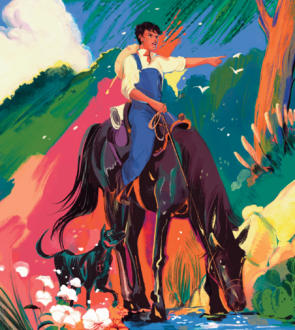 Somewhat. Jovita Valdovinos lived about one hundred years ago. It was a different time. Though, some people in their 60’s plus, have shared that they still remember not being able to wear pants to school. And different regions in the world still don’t condone it. The world-wide feminist movement did a lot to push against our expectations and those that continue the fight for gender justice are doing the world an incredible amount of good. The ability to be who you are in whatever expression that may come, is a true measure of freedom which we all deserve.
Somewhat. Jovita Valdovinos lived about one hundred years ago. It was a different time. Though, some people in their 60’s plus, have shared that they still remember not being able to wear pants to school. And different regions in the world still don’t condone it. The world-wide feminist movement did a lot to push against our expectations and those that continue the fight for gender justice are doing the world an incredible amount of good. The ability to be who you are in whatever expression that may come, is a true measure of freedom which we all deserve.
What was it like working with illustrator Molly Mendoza on capturing the vivid and courageous story of Jovita?
I was so floored when I saw the first sketches. Molly is an incredible talent with a beautiful eye for movement and color. I offered many archival photos to help them understand the style of dress of this particular region in Mexico and the time period and hopefully this helped them visually create the world. But also, in my research trip to conduct interviews, I took pictures of the landscape, of the earth, and of course of Jovita and our relatives and shared them as well. One thing I remember offering as feedback was that the earth in the Sierra de Morones (the area where Jovita rode) is extraordinarily red. I suspect Molly took that little bit of information and ran with it to create some of those stunning spreads.
What did you enjoy most about writing this book?
I enjoyed going on the research trip with my mom who has now passed away and never got to see the final book. She was passionate about my writing about Jovita and loved our pueblo in Mexico so much. It was astounding all the people/places to which she led us on the hunt for all things Jovita. Mami was an incredibly astute and wise woman, this I knew, but she was an invaluable resource on the ground. We were able to go inside Jovita’s home, which sits untouched, as a makeshift museum of Jovita’s life. The furniture is covered in plastic and many photographs hang on the walls. It felt so real and so meaningful to be pulling Jovita’s story out of the ashes of oblivion for readers young and old and having my mother be my guide in that process.
If you could be in the same room as Jovita, what would you like to say to her?
Ah! I love this question! So many things! I would continue to ask her many questions about the war, about what it was like to be a woman dressing as a man, what were her biggest regrets, and her biggest dreams. What was my grandfather like in the war? What was my mother like as a young girl? She would tire of me celebrating her and thanking her for being the courageous spirit that she is.
What would you say you have in common with Jovita?
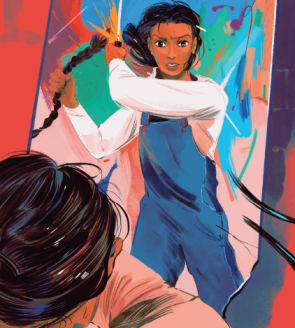 I wanted to dress like a boy when I was a little girl. I wanted to be a boy, in fact. I didn’t have an explanation for it but I had the courage to push against my gender expectations if even for a few years. I eventually succumbed to my societal expectations but one thing that remained was this idea that I could do things outside the box, that I could think and act differently. I also have had a strong sense of justice and have been using the arts as my form of activism for many years. It is important for me to bring equity to the world. I am empowered by all of these notions. It has been the biggest honor to connect with Jovita’s spirit of justice, with her courage and commitment to not be boxed into her gender.
I wanted to dress like a boy when I was a little girl. I wanted to be a boy, in fact. I didn’t have an explanation for it but I had the courage to push against my gender expectations if even for a few years. I eventually succumbed to my societal expectations but one thing that remained was this idea that I could do things outside the box, that I could think and act differently. I also have had a strong sense of justice and have been using the arts as my form of activism for many years. It is important for me to bring equity to the world. I am empowered by all of these notions. It has been the biggest honor to connect with Jovita’s spirit of justice, with her courage and commitment to not be boxed into her gender.
You’ve always “told it like it is” in your books about the realities of growing up both mentally and physically, why do you think it is important to portray those elements of your characters?
I don’t underestimate the emotional nor intellectual capacity of children. We are such complex beings with such an array of emotions and experiences. Children, even if they can’t articulate it, are living, thinking about, questioning, and growing in a grown-up world that doesn’t regard them. We often forget that during war, or celebrations, changing seasons, or breakups, or tragedies, that children are witnesses to each of these things. They, more than anyone, are able to see our contradictions and our loving spirits because they aren’t clouded by societal judgements. Childhood is about growing, learning, and self-exploration. It is important to me to offer information through characters their age that are as complex as they are, that think and feel and wonder about the same things. We do a huge disservice to them to leave out topics and to leave them out of these conversations.
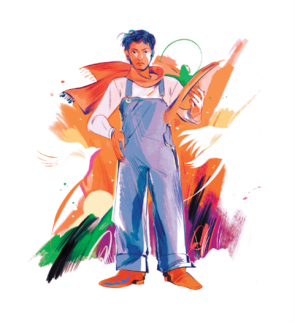 What do you hope young readers will take with them from reading “Jovita Wore Pants”?
What do you hope young readers will take with them from reading “Jovita Wore Pants”?
I want children to see Jovita’s beautiful courage, to know that they too can be as brave and as tenacious in their lives and in the world.

